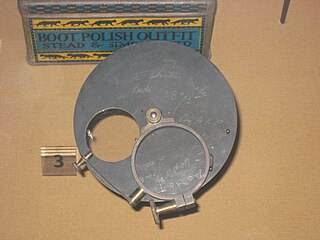
A single-lens reflex camera (SLR) is a camera that typically uses a mirror and prism system that permits the photographer to view through the lens and see exactly what will be captured. With twin lens reflex and rangefinder cameras, the viewed image could be significantly different from the final image. When the shutter button is pressed on most SLRs, the mirror flips out of the light path, allowing light to pass through to the light receptor and the image to be captured.

A camera is an optical instrument to capture still images or to record moving images, which are stored in a physical medium such as in a digital system or on photographic film. A camera consists of a lens which focuses light from the scene, and a camera body which holds the image capture mechanism.

A flash is a device used in photography producing a flash of artificial light at a color temperature of about 5500 K to help illuminate a scene. A major purpose of a flash is to illuminate a dark scene. Other uses are capturing quickly moving objects or changing the quality of light. Flash refers either to the flash of light itself or to the electronic flash unit discharging the light. Most current flash units are electronic, having evolved from single-use flashbulbs and flammable powders. Modern cameras often activate flash units automatically.
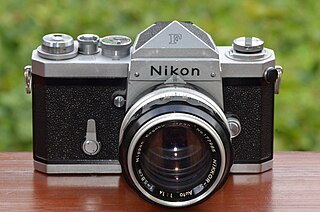
A system camera is a camera with interchangeable components that constitutes the core of a system. Early representatives include Leica I Schraubgewinde (1930), Exakta (1936) and the Nikon F (1959). System cameras are often single-lens reflex (SLR) or twin-lens reflex (TLR) but can also be rangefinder cameras or, more recently, mirrorless interchangeable-lens cameras.

The Nikon Coolpix 950 was a digital camera released by Nikon in early 1999. The 950 model superseded the Coolpix 900 in the Nikon Coolpix series. The Coolpix 950 was a durable camera with swivel lens, magnesium body, a maximum resolution of 1600×1200, 3× optical zoom and a minimum focusing distance of 2 cm. It was in turn superseded by the Coolpix 990.
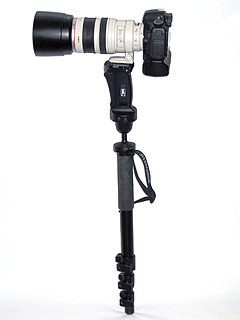
A monopod, also called a unipod, is a single staff or pole used to help support cameras, binoculars, rifles or other precision instruments in the field.
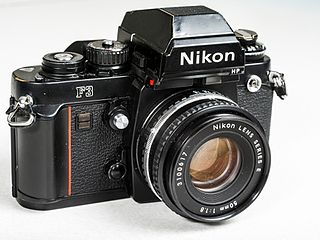
The Nikon F3 was Nikon's third professional single-lens reflex camera body, preceded by the F and F2. Introduced in 1980, it had manual and semi-automatic exposure control whereby the camera would select the correct shutter speed. The Nikon F3 series cameras had the most model variations of any Nikon F camera. It was also the first of numerous Nikon F-series cameras to be styled by Italian designer Giorgetto Giugiaro, and to include a red stripe on the handgrip – a feature that would later become a signature feature of many Nikon cameras.

The Canon T50, introduced in March 1983 and discontinued in December 1989, was the first in Canon's new T series of 35mm single-lens reflex cameras compatible with Canon's FD lens mount. SLR sales were falling in 1983 from the market's 1981 peak, and Canon chose to try greater automation to revive sales and remain competitive. This approach had found favor in compact cameras such as the AF35M "Autoboy" (Japan) or "Sure Shot" (US). The T50 had a power winder built in giving a continuous shooting rate of 1.4 frames per second, as well as an advanced auto-exposure mode, although it was still a manual focus camera. Unlike those compact cameras and the higher-end models in the T series, the T50 did not have power rewind, relying on a manual crank. The camera's electric systems were powered by two AA batteries in the grip, which gave enough power to shoot 75 24-exposure rolls, or 50 36-exposure rolls.
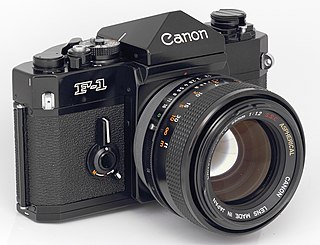
The Canon F-1 is a 35 mm single-lens reflex camera produced by Canon of Japan from March 1971 until the end of 1981, at which point it had been superseded by the New F-1 launched earlier that year. The Canon FD lens mount was introduced along with the F-1, but the previous Canon FL-mount lenses and older R- series lenses were also compatible with the camera with some limitations. The Canon F-1 was marketed as a competitor to the Nikon F and Nikon F2 single lens reflex cameras by Nikon.
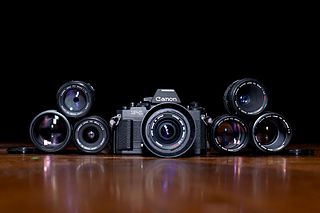
The Canon New F-1 replaced the F-1n as Canon's top-of-the-line 35mm single-lens reflex camera in 1981. Like the earlier models, the New F-1 takes FD-mount lenses. Although no date has ever been confirmed, it is thought that the last New F-1 was still being made in 1992. It was officially discontinued in 1994, and factory support ended in 2004.

The Nikon D200 is a 10.2-megapixel digital single-lens reflex camera that falls between entry-level/midrange DSLR cameras such as the Nikon D40, Nikon D40x, and D80 and high-end models such as the Nikon D2Hs and D2Xs. It was released by the Nikon Corporation in November 2005. The D200 was succeeded by the D300 in August 2007.

The Minolta XG-M was a 35mm single-lens reflex camera introduced in 1981 by Minolta of Japan. It was also known as the X-70 on the Japanese market, in which it was not available until 1982. When released, it was the top model in Minolta's XG series of consumer-grade manual focus SLRs, replacing the XG-9. Changes from that model included a metered manual mode, and a revised body style with rearranged controls. This was also the first camera to use Minolta's new logo, which was used until the 2003 merger into Konica Minolta.

Minolta 16 refers to a line of 16mm subminiature cameras made by Minolta between 1955 and 1974. The negative size was 10x14 mm for the earlier models, later, a larger format, 12x17 mm was adopted, using single-perforated 16 mm film. It was possible to load your own cassettes, and also develop the film using a special developing tank with a spiral insert for 16 mm film.

The EOS-1N is a 35mm single lens reflex (SLR) camera body produced by Canon. It was announced by Canon in 1994, and was the professional model in the range, superseding the original EOS-1. The camera was itself superseded by the EOS-1v in 2000.

The Nikon F90 is a 35mm SLR camera manufactured between 1992 and 2001 and replaced the earlier Nikon F-801. At the time of its release it was noted for its fast autofocus speed compared to previous Nikon models, which had lagged behind competitor Canon's. It was thus seen by many as a 'stop-gap' measure to prevent the mass migration of many Nikon-using professional photographers to Canon, as Nikon's next fully professional camera, the F5, was some time away from release. The Nikon F4, the professional model available at the time of the F90's release, had very slow autofocus compared to Canon's autofocus SLRs.

Sports photography refers to the genre of photography that covers all types of sports.

The Canon EOS 100 is a 35 mm autofocus SLR camera introduced by Canon in 1991. It was marketed as the EOS Elan in North America. It was the second camera in the EOS range to be targeted at advanced amateur photographers, replacing the EOS 650.

The Canon BG-ED3 is a battery grip manufactured by Canon for certain models of its EOS digital SLR camera range. It was originally designed for the Canon EOS D30. It can hold 2 BP-511 or BP-511A batteries, effectively doubling the battery life of these cameras. The BG-ED3 can also accept the DR-400 DC Coupler, which when attached to a CA-PS400 or AC adapter ACK-E2, draws directly from an AC power source. A BG-ED3 is not necessary to use a compatible EOS camera with the DR-400. This battery grip also has extra buttons for controlling the camera. It has a shutter release button on the corner, making it easier to shoot vertically framed shots, as the button will be under the right index finger of the photographer. There are other buttons, a switch, and a dial. A larger dial is used to turn the screw that secures the grip to the camera body. The camera body's battery cover can be removed without tools since it is held in place with a spring-loaded pin that can be retracted by a fingernail. The BG-ED3 has space to store the camera body's detached battery cover next to the post that slides into the camera body's battery compartment.
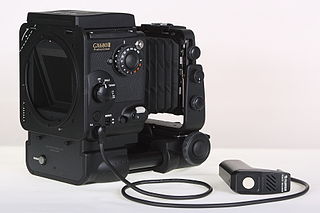
The Fuji GX680 is a single lens reflex system camera for medium format film produced by Fujifilm with interchangeable camera lenses and interchangeable film holders for the unusual film format 6x8cm on 120 and 220 roll film. One highlight is the mounting of the lens on a lens board running on a rail connecting lens and camera body by a bellows like a view camera. In contrast to related medium-format-cameras of other makers, e.g. Mamiya RB67 and RZ67 and Rolleiflex SL66, the lens board can be shifted right, left, up and down for perspective control, the lens board can also be tilted on horizontal and vertical axis for control of depth of field using the Scheimpflug principle. Therefore the Fuji GX680 has the optical skills of a large format camera, only limited by restricted movability of the lens board, enabling the camera also for architectural photography. The Fuji GX680 has quite large physical dimensions for a medium-format-camera, but compared to studio-large-format-cameras the Fuji GX680 is a somewhat more compact model. Although the Fuji GX680 was designed for studio-work due to its size and weight, a neck-strap was offered for mobile work.

The Nikon 1 J1 is a Nikon 1 series high-speed mirrorless interchangeable-lens camera with 1" sensor size launched by Nikon on September 21, 2011. It is a new model that focuses on high-performance, portability and versatility. Nikon lists the estimated selling price of the Nikon 1 J1 One-Lens Kit in the United States at $649.95. Released on October 20, 2011, this kit comes with the 1 NIKKOR VR 10-30mm f/3.5-5.6 lens.



